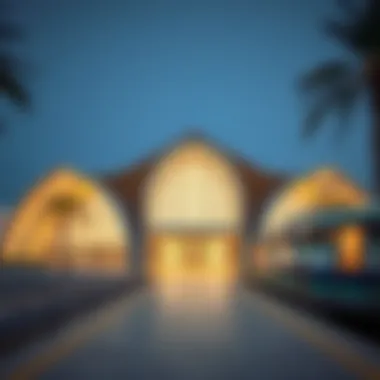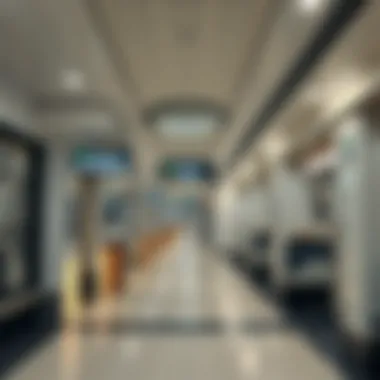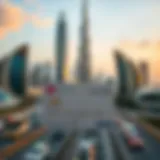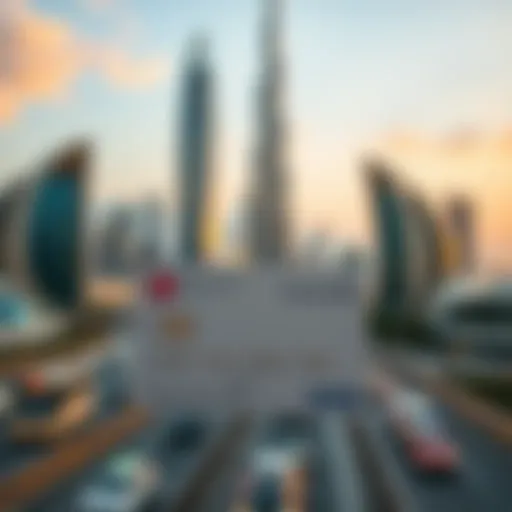Jaddaf Metro Station: A Hub of Connectivity in Dubai


Intro
In the heart of Dubai’s bustling landscape, Jaddaf Metro Station emerges as a vital link in the city’s intricate transportation lattice. With its strategic location, this metro station not only cuts down travel time but also serves as a conduit for communities, weaving together diverse neighborhoods. By examining the dynamics surrounding Jaddaf Metro Station, we can unearth the layers of socio-economic factors at play, discover the operational elements that make it a beacon of mobility, and explore the potential future developments that could further enhance its relevance.
Understanding the role of Jaddaf Metro Station extends beyond just its physical structure. It's about grasping how it connects people to opportunities and services, fostering a sense of community while facilitating economic growth. As we delve deeper, we will explore key aspects of market trends, property investment strategies, and the overarching implications for stakeholders in Dubai's real estate sector.
Let’s embark on this analytical journey to appreciate the influence of Jaddaf Metro Station on urban mobility and community connectivity in one of the fastest-growing cities worldwide.
Intro to Jaddaf Metro Station
The Jaddaf Metro Station stands as more than just a point on a map; it is a vital cog in the larger machine of Dubai's transportation framework. Given the city's ambitions to expand and improve its public transport network, understanding the role of this station provides significant insights into how it enhances community interaction and mobility. It not only connects diverse neighborhoods but also plays a crucial role in shaping the urban landscape.
Overview of Dubai's Metro System
Dubai's Metro system is a game changer, weaving through the city's fabric with a network that stretches over 90 kilometers. Opened in 2009, it has evolved to be a principal mode of transportation for residents and tourists alike. The red and green lines served by this system link key areas, making commutes more efficient and environmentally friendly compared to traditional means of transport. By providing safe, reliable, and cost-effective travel options, the metro system stands as a testament to Dubai's rapid urban development.
Despite challenges like the scorching desert heat, trains run at high frequency, ensuring that waiting times are minimal. For individuals looking to move about Dubai, the Metro represents a significant boon, especially when considering the city's notorious traffic bottlenecks and congestion.
Its growing network reflects the strategic planning behind urban mobility, pushing towards sustainability and ease of access. Ultimately, the Metro has become a crucial contributor to Dubai's ambitions, spearheading both environmental and economic benefits.
Geographical Significance of Jaddaf
Nestled on the banks of Dubai Creek, Jaddaf holds unique geographical importance. It acts as an intersection for communities, drawing in residents from various residential areas while offering easy access to key commercial districts. Situated strategically, this metro station connects not only locals but also tourists who wish to explore the rich heritage and contemporary attractions of the city.
The proximity of Jaddaf to cultural landmarks such as the Dubai Museum and the vibrant activities along the creek enhances its significance further. Beyond tourism, it supports daily commuters and residents, offering them a convenient passage through the city. In essence, the Jaddaf Metro Station embodies the city’s efforts to foster connectivity, ensuring that communities remain linked and accessible as urban growth continues.
Historical Context
Understanding the historical context of Jaddaf Metro Station is essential for grasping its role within Dubai’s comprehensive transportation network and the city’s urban development. This section will explore how the station came into being and what it represents over time. The evolution of this transit hub reflects broader trends in public transport and urban planning in Dubai.
Construction and Development Timeline
The story of Jaddaf Metro Station began in the early 2000s, amid a colossal push for metro expansion in Dubai. Construction started in 2009, coinciding with the ambitious aim of developing an efficient public transport system that could accommodate the rapidly growing population of the emirate. This surge in growth has driven the need for a reliable metro system, leading to the establishment of the Jaddaf station as part of the Green Line, which opened its doors to the public in 2011.
Understanding this timeline helps to illustrate a crucial period in Dubai's history where investment in infrastructure was paramount. Here are some key milestones in the station's journey:
- 2003: Planning for the Dubai Metro system begins.
- 2007: The core design phase is concluded, and works commence.
- 2009: Construction of the Jaddaf station starts.
- 2011: Jaddaf Metro Station is officially inaugurated, signaling a new era of connectivity for surrounding neighborhoods.
The completion of Jaddaf Metro Station was both timely and strategic. It emerged during a time when local authorities emphasized sustainable urban growth, aiming to reduce traffic congestion and promote eco-friendly transport alternatives. Furthermore, the station was designed not just as a transit point but as a connector of communities, offering direct accessibility to key areas within Dubai.
The Role of Jaddaf in Transportation Evolution
Jaddaf Metro Station holds a pivotal role in the evolving landscape of Dubai’s transportation system. It serves as a critical link between various urban areas, particularly connecting the waterfront destinations like the Dubai Creek and the business hubs in Bur Dubai.
At its conception, transportation in Dubai was predominantly reliant on private vehicles, which contributed to traffic jams and pollution. With the introduction of the metro, and specifically through the establishment of Jaddaf Station, a significant shift began to take shape. The metro provided reliable, speedy, and cost-effective travel options, making public transport more appealing for daily commuters.
Moreover, Jaddaf's proximity to several cultural and recreational spots enhances its utility. The station has transformed into a popular access point for residents and visitors heading to attractions like Dubai’s art districts, making it integral to the city’s socio-cultural fabric.
In this historical context, Jaddaf Metro Station symbolizes a forward-thinking approach to urban mobility. It’s a prototype of how cities can respond to the challenges posed by growth — emphasizing not just mobility, but community integration and sustainability. The station isn’t merely a stop along the metro line; it's part of a larger strategy to enrich lives and enhance urban living in Dubai, thereby cementing its significance within the history of the emirate's development.
Infrastructure and Design
Infrastructure and design are the backbone of any efficient metro station, and Jaddaf Metro Station is no exception. The integration of architectural innovation and sustainable practices greatly enhances the usability and appeal of this transit hub. Understanding these factors helps stakeholders appreciate the long-term benefits they bring not only to commuters but also to the entire community.
Architectural Features of Jaddaf Station


The architectural features of Jaddaf Metro Station are a blend of functionality and aesthetics that cater to the needs of its diverse users. At first glance, the station presents an inviting facade that combines modern designs with reference to the local culture. Large open spaces flood the waiting areas with natural light, helping to create a pleasant atmosphere for commuters.
Key features include:
- Accessibility: Ramps and elevators ensure that individuals with disabilities can navigate the space comfortably.
- Waiting Areas: Comfortable seating is available, allowing travelers to wait without feeling cramped.
- Signage and Navigation: Clear visual cues guide passengers with ease, minimizing confusion during peak hours.
Additionally, the incorporation of effective sound insulation maintains a quieter environment, enhancing the overall commuter experience. This attention to detail makes Jaddaf a standout in the metro system, setting a new standard for future stations.
Sustainability Initiatives
With growing concern over environmental issues, Jaddaf Metro Station takes significant steps towards sustainability. Not only does it address current needs, but it also prepares for future challenges associated with urban expansion.
Noteworthy sustainability initiatives include:
- Solar Panels: Installed on rooftops, these panels harness energy from the sun, reducing reliance on non-renewable sources.
- Rainwater Harvesting Systems: This technology collects rainwater for use in station maintenance, thereby conserving valuable resources.
- Green Spaces: The incorporation of greenery around the station contributes to biodiversity and air quality improvement, creating a more pleasant environment for commuters.
These initiatives are critical in setting a precedent for sustainable development in Dubai's infrastructure ecosystem, showing that progress does not have to come at the expense of the environment. Overall, the thoughtful design and sustainable practices at Jaddaf Metro Station serve as an exemplary model, encouraging future public transport projects to prioritize both functionality and ecological responsibility.
Connecting Communities
The Jaddaf Metro Station plays a pivotal role in bridging the gaps between neighborhoods and fostering community connectivity in Dubai. Its location is more than just a point on the map; it serves as a lifeline that links various demographic segments, enhancing the way people move around the city. Considering Dubai's rapid urbanization, the importance of connecting dispersed communities cannot be overstated. With this in mind, it’s essential to explore the intricate relationships between nearby neighborhoods and how they benefit from the station’s presence.
Adjacent Neighborhoods and Demographics
Jaddaf Metro Station is strategically positioned to serve a diverse array of neighborhoods, each with its own unique character and community essence. Just a stone's throw away is the culturally rich Al Jaddaf area, known for its multicultural population and vibrant local life. Residents here hail from various parts of the world, creating a melting pot of languages and traditions. The accessibility provided by the metro encourages greater interaction among these groups, turning a commuter journey into a chance for cultural exchange.
In addition, the proximity to upscale areas such as Dubai Creek enables cross-pollination between different social classes. Commuters from affluent neighborhoods can easily access facilities and amenities in less affluent regions. This dynamic helps to blur the lines between socio-economic boundaries, making the city feel more inclusive. The station also connects families, students, and professionals who work in different parts of the city, catering to the practical needs of a population that values mobility.
Key demographic insights include:
- High expatriate population, fostering a multi-cultural environment.
- Families seeking connectivity to schools and recreational areas.
- Young professionals commuting daily to business hubs.
The Jaddaf Metro Station serves as a central point that supports this diverse mix, reinforcing its role in community interaction and cohesion.
Impact on Local Businesses
The influence of Jaddaf Metro Station on local businesses is profound and multi-faceted. With increased foot traffic, local shops and eateries are experiencing a surge in customers that translates into higher sales. The easy access to transportation encourages not just locals but also visitors to explore and patronize these businesses. Small enterprises, particularly those that cater to the immediate community's needs, are seeing a notable uptick in visibility and viability.
For instance, cafes near the station benefit significantly from morning commuters grabbing coffee on their way to work. Similarly, grocery stores have witnessed a jumping in clientele, with residents opting for convenient shopping options before hopping on a train. The presence of the metro station enriches the local economy by:
- Attracting a diverse clientele from surrounding neighborhoods.
- Increasing the demand for goods and services.
- Creating partnerships among businesses for promotions and events.
"A thriving local economy is a testament to the strength of community connections forged through shared access to transportation."
Overall, the station serves as an economic catalyst, spurring growth for many local enterprises while contributing to a vibrant community atmosphere. By linking the dots between social mobility and business development, Jaddaf Metro Station enhances both community cohesion and economic prosperity.
Mobility Enhancements
The concept of mobility enhancements is pivotal in understanding and appreciating the significance of Jaddaf Metro Station within Dubai's public transport framework. Such enhancements not only ease commuting but also forge stronger links among communities, fostering social cohesion and economic growth. Investing in mobility features can significantly transform how residents and visitors interact with the city.
Key Elements of Mobility Enhancements
To understand mobility enhancements, we can break it down into several critical elements that influence the efficacy of Jaddaf Metro Station:
- Efficiency: A streamlined transit process minimizes waiting times and transfers, making it easier for commuters to reach their destinations smoothly and swiftly.
- Safety: High safety standards ensure that all users feel secure while utilizing the metro services, which attracts more people to public transport.
- Comfort: Well-designed spaces, including waiting areas and smooth ride experiences, elevate the quality of daily travel, encouraging a shift from private vehicles to public transport.
- Flexibility: Offering various travel options, including last-mile connections, provides commuters the freedom to customize their journeys according to their specific needs.
Accessibility Features for All Users


Accessibility in the Jaddaf Metro Station has been a primary consideration in its design. By accommodating all users, including those with disabilities, families with strollers, and elderly passengers, the station aims to create a welcoming environment.
Some notable accessibility features include:
- Ramps and Elevators: Designed for convenience, these features allow easy access to platforms without requiring stairs.
- Visual and Audio Aids: Installations such as tactile guidance paths and audible announcements help visually impaired and hearing-impaired users navigate the station with ease.
- Dedicated Seating: Spaces reserved for those with disabilities or elderly travelers ensure their comfort while waiting for metro services.
These features not only reflect a commitment to inclusivity but also contribute significantly to increasing overall ridership. Making public transport accessible broadens the scope of who can and will use the system.
Integration with Other Transport Systems
The effectiveness of Jaddaf Metro Station is further amplified through its integration with other modes of transport. This integrated approach presents a comprehensive mobility solution that smooths the journey from one place to another in Dubai. By providing seamless connections to various transport networks, users can transit with minimal hassle.
- Bus Connections: Proximity to bus terminals makes Jaddaf a pivotal interchange point for commuters requiring complementary routes.
- Ferry Services: The station's closeness to water transport enhances accessibility to Dubai's waterfront areas, providing a scenic route that appeals to residents and tourists alike.
- Car Parking Facilities: Ample parking space encourages drivers to transition from personal vehicles to public transport, helping to reduce congestion on the roads.
- Ride-Sharing: Easy access to ride-hailing services provides flexibility for users, making it possible to cover the entire city without relying solely on personal cars.
Each of these integrations contributes to a holistic transport experience that promotes urban mobility while encouraging sustainable practices. Simplifying connections between different transport systems allows Jaddaf to serve a broad demographic, reinforcing its role as a linchpin in the new Dubai landscape.
Socio-Economic Impact
The Jaddaf Metro Station is not merely a stop on a train line; it holds significant sway over both local and broader socio-economic dynamics. Its positioning within Dubai's intricate public transport framework has far-reaching implications that affect residents, businesses, and investors alike. Understanding these impacts is crucial for various stakeholders—be it homebuyers eyeing property investments, agents seeking to understand market trends, or analysts evaluating urban development. The interplay between transportation and socio-economics at Jaddaf provides insights into how urban infrastructure can catalyze growth and elevate community engagement.
Effects on Property Values
One cannot discuss the socio-economic impact of Jaddaf Metro Station without addressing its influence on property values. Generally, properties located near efficient transportation hubs often command higher prices. This trend is particularly pronounced around Jaddaf. As demand increases for residential and commercial real estate within close proximity to the metro station, property values soar.
For instance, areas within a 1-kilometer radius of Jaddaf have seen a consistent uptick in prices over recent years. So why does this happen? Well, ease of mobility is a game changer. Potential homeowners and renters are drawn to locations where commuting is a breeze, naturally leading to escalated demand.
On the flip side, as prices climb, the risk of affordability challenges for existing residents also pops up. Some segments of the population may feel the pinch as costs outstrip income growth, leading to potential displacement.
Key Considerations:
- Market Dynamics: Increased property demand generally leads to a healthy housing market but can also create bubbles if prices inflate too quickly.
- Investor Insight: Investors might see Jaddaf as a golden opportunity. Understanding price trajectories can aid in making informed decisions.
Job Creation and Economic Growth
Another pillar of the socio-economic impact revolves around job creation and overall economic growth prompted by the metro station. Jaddaf serves as a nexus linking businesses with customers who rely on public transport. As new businesses pop up to cater to this influx of commuters, the job market naturally expands. This phenomenon not only nurtures local entrepreneurship but also attracts larger commercial enterprises, further fueling economic vitality.
A specific example can be seen in the rising number of cafes, retail outlets, and service-oriented businesses positioning themselves near the metro station. These businesses thrive on the foot traffic generated by commuters. With the station acting as a magnet for customers, local businesses experience increased sales, leading to expansions and additional hiring—a virtuous cycle of growth and employment.
Additionally, government and private investments in infrastructure strengthen this cycle. Enhanced connectivity often leads to improved economic outcomes for the region.
Points to Ponder:
- Long-Term Viability: As more jobs are created, the local economy benefits, but sustainability hinges on continued investment and consumer engagement.
- Diversity of Employment: A range of job opportunities, from retail to service industries, aids in balancing the job market and catering to varying skill sets.
In summary, the socio-economic impact of Jaddaf Metro Station is a tapestry woven from various threads—property values, employment opportunities, and community dynamics. As this nexus continues to evolve, understanding these interactions will be vital for stakeholders keen on navigating the complexities of Dubai's vibrant urban landscape.
The influence of the Jaddaf Metro Station extends beyond transportation; it shapes communities, livelihoods, and the future of urban living in Dubai.
Challenges and Considerations
When assessing the Jaddaf Metro Station, a thorough understanding of the challenges and considerations surrounding it is crucial. This section will explore the operational hurdles faced by the station and its impact on commuter experiences, providing insights into aspects that can significantly enhance both its functionality and the overall user experience.
Operational Issues and Solutions
Jaddaf Metro Station, like many transit hubs, grapples with a range of operational issues. These can stem from over-crowding during peak hours, maintenance challenges, or even technology failures. In a vibrant city like Dubai, where urban mobility is paramount, addressing these challenges is key to ensuring efficient transport services.


One notable issue often encountered is the synchronization of train schedules with other transport options. If the metro service does not align well with bus or boat timings, passengers might face longer waiting periods, leading to dissatisfaction. Implementing real-time data systems could effectively address this problem. By providing commuters with live updates on waiting times and train availability through mobile applications, users can plan their journeys better, mitigating the impact of any delays.
Similarly, integrating a feedback mechanism for users can play a significant role in operational improvements. Regularly collecting and analyzing feedback can unveil persistent pain points that may not be immediately visible. It puts the tools back in hands of the commuters, giving them the opportunity to voice concerns while simultaneously helping authorities address any recurrent issues.
Addressing Commuter Experiences
The commuter experience at Jaddaf Metro Station encompasses much more than just the transportation itself. It involves the entire journey from entering the station to exiting at their destination. Ensuring that this experience is smooth, comfortable, and efficient is crucial, particularly for residents and visitors who rely on the metro as their primary mode of transportation.
One crucial area for improvement includes the accessibility of the station. Facilities for individuals with disabilities, such as elevators and tactile guidance systems, should be thoroughly evaluated and maintained. In many instances, the perception of the metro system hinges on its inclusiveness.
Moreover, the ambiance of the station can play a role in how commuters feel about using the metro. Maintenance of the station's cleanliness, proper lighting, and clear signage help create a welcoming environment. Incorporating local art displays could also make the station a cultural connection point, enhancing overall commuter morale.
In summary, addressing these challenges is not just about fixing current issues; it also involves anticipating future needs as the community around Jaddaf continues to grow. Simplifying the commuter experience through thoughtful design and responsive service will undoubtedly elevate Jaddaf Metro Station from merely being a transit hub to a cornerstone of the local community.
"Transport links are the lifeblood of urban development, linking neighborhoods and playing a central role in shaping socio-economic landscapes."
This approach not only fosters a smoother transit experience but also strengthens the sense of community around Jaddaf, encouraging both residents and visitors to engage more deeply with their surroundings.
Future Developments
The future of Jaddaf Metro Station not only shapes the transportation dynamics of Dubai but also has far-reaching implications for community connectivity and economic growth. Understanding these projected changes is crucial for stakeholders, such as homebuyers, investors, agents, analysts, and expats, who are keen on capitalizing on new opportunities in the rapidly evolving urban landscape. This section outlines the planned extensions and their potential impact along with how upcoming real estate projects may align with these developments.
Planned Extensions to Jaddaf
The anticipated extensions to Jaddaf Metro Station are part and parcel of Dubai's expansive vision for its metro network. These plans aim to enhance commuter experience and accessibility, while simultaneously encouraging urban sprawl in targeted directions. One key piece of information to consider is how these extensions will connect to newly developing residential areas and commercial hubs.
Furthermore, the integration with existing lines is expected to facilitate a smoother transit experience. For example, linking Jaddaf Metro Station with the proposed routes to Dubai Marina will cut down travel times significantly for commuters.
"Planned extensions are not just about reaching new destinations; they are about building a fabric that stitches communities together."
The estimated timeline for these extensions indicates that construction may commence within the next three years, with completion projected shortly after. Factors such as funding, environmental considerations, and community input will shape the progress and final configurations of these enhancements.
Influence of Upcoming Real Estate Projects
As Jaddaf Metro Station gears up for its expansions, the looming real estate projects in the vicinity promise to alter the neighborhood's demographic and economic landscape. Major developers are focusing on this area, eyeing it as a prime opportunity for mixed-use developments, which could blend residential, commercial, and recreational spaces.
Among several proposed initiatives, one stands out — a multi-use complex that includes luxury apartments and retail spaces aimed at catering to the lifestyle of professionals and expats. This trend might lead to increased property values, creating a ripple effect that could benefit local businesses, especially those that sprang up to serve the conveniences promised by the metro's accessibility.
From the perspective of homebuyers and investors, the arrival of such projects can lead to careful deliberation about timing and investment strategy. Factors to keep an eye on include:
- Market Demand: The interest and growth rates within surrounding neighborhoods could dictate property prices.
- Infrastructure Investment: As public transport amenities improve, we could see an uptick in property values, making it a wise time to buy.
- Community Engagement: Future developments heavily depend on community support to ensure that changes reflect residents’ needs and preferences.
Ending
Summarizing the Importance of Jaddaf Station
Jaddaf Metro Station stands as a pivotal point in Dubai's transportation map, linking diverse neighborhoods and magnifying the city’s mobility. This station is not merely a stop along the route but a vibrant hub that enhances connectivity for thousands of commuters daily. The integration of Jaddaf into the Greater Metro System has expanded access, making it a lifeline for residents and visitors who rely on public transport. Its strategic location near recreational centers and residential developments bolsters the overall utility of the station, which supports the transportation needs of an ever-growing population. Notably, Jaddaf Station plays a critical role in promoting sustainable urban development by minimizing dependency on personal vehicles, thereby contributing to an eco-friendlier cityscape.
The significance goes beyond transportation; the station also serves as a catalyst for economic interaction among nearby businesses. With increased foot traffic, local merchants and service providers have witnessed a boost in patronage, thus supporting small enterprises and contributing to a vibrant local economy. Understanding the importance of Jaddaf Station is crucial for stakeholders, especially for homebuyers and investors navigating Dubai’s dynamic real estate market.
Looking Ahead: The Role of Jaddaf in Dubai's Urban Landscape
The future of Jaddaf Metro Station is inherently intertwined with Dubai’s ambitious plans for urban growth and transformation. With ongoing infrastructural projects, the station is positioned to adapt and evolve to meet the needs of its surrounding environment. Upcoming developments are set to redefine accessibility and travel efficiency, aiming at making commuting an even more pleasant experience.
Planned extensions of the metro network promise to cultivate additional connections not only to Jaddaf but also to surrounding areas, presenting new avenues for residential and commercial investment. The urban landscape around Jaddaf is likely to experience a surge in real estate projects, influenced by the increased ease of connectivity.
“Jaddaf Metro Station is not just a transportation point; it’s a gateway to a thriving future for communities in Dubai.”
Furthermore, as urban planners focus on creating mixed-use developments, Jaddaf will likely witness a blending of residential, commercial, and recreational spaces, offering a holistic living experience. Investors and homebuyers should keep a watchful eye on emerging trends, as the evolution of Jaddaf Station will considerably shape the real estate dynamics in the coming years. The ongoing interplay of infrastructure development and real estate investment will be vital in enhancing the overall lifestyle of residents, solidifying Jaddaf’s importance within Dubai's continually expanding urban fabric.
Through strategic developments and community-focused initiatives, Jaddaf is set to cement its role as a cornerstone in Dubai’s transportation narrative, enhancing connectivity and fostering socio-economic growth for all.







